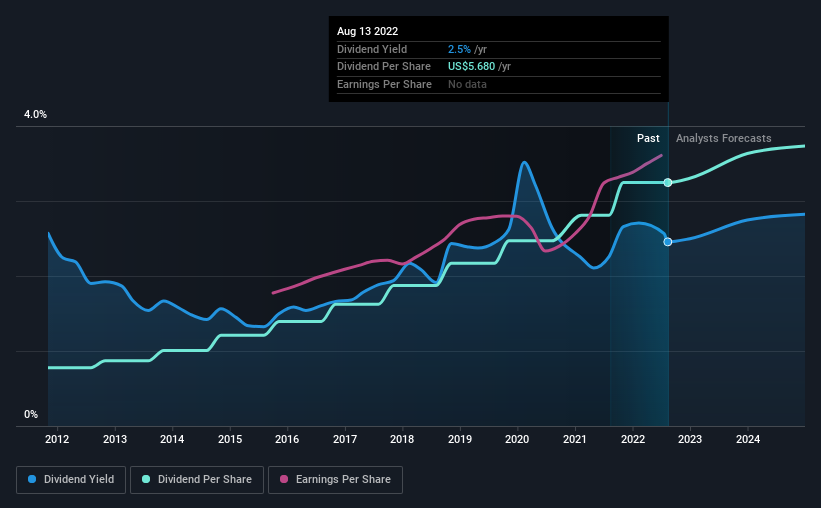Snap-on Incorporated (NYSE:SNA) Looks Like A Good Stock, And It's Going Ex-Dividend Soon
Readers hoping to buy Snap-on Incorporated (NYSE:SNA) for its dividend will need to make their move shortly, as the stock is about to trade ex-dividend. The ex-dividend date is one business day before a company's record date, which is the date on which the company determines which shareholders are entitled to receive a dividend. The ex-dividend date is important because any transaction on a stock needs to have been settled before the record date in order to be eligible for a dividend. Thus, you can purchase Snap-on's shares before the 18th of August in order to receive the dividend, which the company will pay on the 9th of September.
The company's next dividend payment will be US$1.42 per share, and in the last 12 months, the company paid a total of US$5.68 per share. Based on the last year's worth of payments, Snap-on has a trailing yield of 2.5% on the current stock price of $231.36. If you buy this business for its dividend, you should have an idea of whether Snap-on's dividend is reliable and sustainable. We need to see whether the dividend is covered by earnings and if it's growing.
Check out our latest analysis for Snap-on
Dividends are typically paid from company earnings. If a company pays more in dividends than it earned in profit, then the dividend could be unsustainable. Snap-on paid out a comfortable 34% of its profit last year. A useful secondary check can be to evaluate whether Snap-on generated enough free cash flow to afford its dividend. It distributed 44% of its free cash flow as dividends, a comfortable payout level for most companies.
It's positive to see that Snap-on's dividend is covered by both profits and cash flow, since this is generally a sign that the dividend is sustainable, and a lower payout ratio usually suggests a greater margin of safety before the dividend gets cut.
Click here to see the company's payout ratio, plus analyst estimates of its future dividends.
Have Earnings And Dividends Been Growing?
Companies with consistently growing earnings per share generally make the best dividend stocks, as they usually find it easier to grow dividends per share. If business enters a downturn and the dividend is cut, the company could see its value fall precipitously. Fortunately for readers, Snap-on's earnings per share have been growing at 12% a year for the past five years. Earnings per share have been growing rapidly and the company is retaining a majority of its earnings within the business. This will make it easier to fund future growth efforts and we think this is an attractive combination - plus the dividend can always be increased later.
Another key way to measure a company's dividend prospects is by measuring its historical rate of dividend growth. In the past 10 years, Snap-on has increased its dividend at approximately 15% a year on average. It's great to see earnings per share growing rapidly over several years, and dividends per share growing right along with it.
The Bottom Line
Is Snap-on an attractive dividend stock, or better left on the shelf? We love that Snap-on is growing earnings per share while simultaneously paying out a low percentage of both its earnings and cash flow. These characteristics suggest the company is reinvesting in growing its business, while the conservative payout ratio also implies a reduced risk of the dividend being cut in the future. There's a lot to like about Snap-on, and we would prioritise taking a closer look at it.
On that note, you'll want to research what risks Snap-on is facing. For example - Snap-on has 1 warning sign we think you should be aware of.
Generally, we wouldn't recommend just buying the first dividend stock you see. Here's a curated list of interesting stocks that are strong dividend payers.
Have feedback on this article? Concerned about the content? Get in touch with us directly. Alternatively, email editorial-team (at) simplywallst.com.
This article by Simply Wall St is general in nature. We provide commentary based on historical data and analyst forecasts only using an unbiased methodology and our articles are not intended to be financial advice. It does not constitute a recommendation to buy or sell any stock, and does not take account of your objectives, or your financial situation. We aim to bring you long-term focused analysis driven by fundamental data. Note that our analysis may not factor in the latest price-sensitive company announcements or qualitative material. Simply Wall St has no position in any stocks mentioned.
Join A Paid User Research Session
You’ll receive a US$30 Amazon Gift card for 1 hour of your time while helping us build better investing tools for the individual investors like yourself. Sign up here

 Yahoo Finance
Yahoo Finance 
